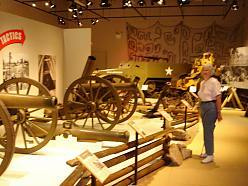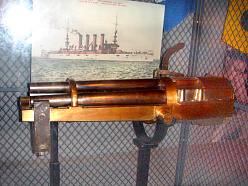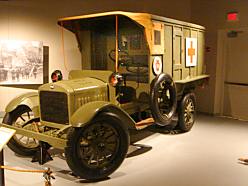The Pennsylvania Military
Museum
Shrine of the 28th Infantry Division, the Pennsylvania National Guard
Boalsburg, PA
August 12th, 2007
 While
traveling through Pennsylvania, Laura found one of those places every war buff
loves: a military museum. The Pennsylvania military museum is
dedicated to those who served in the last century of wars and who came from
Pennsylvania. The building's facade looks like the blouse of a well
decorated soldier. It is painted in the design of the highest awards of
the military services. Along the path leading to the museum is a placard
that identifies the individual medals portrayed on the building. Around the expansive
property
While
traveling through Pennsylvania, Laura found one of those places every war buff
loves: a military museum. The Pennsylvania military museum is
dedicated to those who served in the last century of wars and who came from
Pennsylvania. The building's facade looks like the blouse of a well
decorated soldier. It is painted in the design of the highest awards of
the military services. Along the path leading to the museum is a placard
that identifies the individual medals portrayed on the building. Around the expansive
property  are
parked all kinds of military hardware, from
tanks to cannons. There is something from just about every campaign over the
last 100 years. There's even a display of various smooth bore cannons from the
1800s. There are far too many things to describe but I will touch on just a
few. Our
first visit was to the smooth bore cannon display. There were
are
parked all kinds of military hardware, from
tanks to cannons. There is something from just about every campaign over the
last 100 years. There's even a display of various smooth bore cannons from the
1800s. There are far too many things to describe but I will touch on just a
few. Our
first visit was to the smooth bore cannon display. There were several
classics including the infamous Napoleon. The Napoleon cannon was the most common
artillery piece in the Civil War. Named after its designer, The Emperor of
France, this 12 pounder quickly replaced most other cannons of its size.
It was capable of both direct fire and raised fire, as if used as a mortar.
Coupled with the new "canister" shell, filled with ball bearings, it
became the shredder of exposed advancing infantry. We wandered down the isle and
found a point of interest: the very first Tank made in America.
Actually it was once called a special tractor and was a copy of a Renault
vehicle made in France for use in WWI. It
had a crew of just 2, a commander and a driver/gunner. Able to fire
several
classics including the infamous Napoleon. The Napoleon cannon was the most common
artillery piece in the Civil War. Named after its designer, The Emperor of
France, this 12 pounder quickly replaced most other cannons of its size.
It was capable of both direct fire and raised fire, as if used as a mortar.
Coupled with the new "canister" shell, filled with ball bearings, it
became the shredder of exposed advancing infantry. We wandered down the isle and
found a point of interest: the very first Tank made in America.
Actually it was once called a special tractor and was a copy of a Renault
vehicle made in France for use in WWI. It
had a crew of just 2, a commander and a driver/gunner. Able to fire either
a 37 mm cannon or a 30 cal. machine gun it lumbered along at just 5 mph.
Appearing early in 1919, it was manufactured too late to see action during the first war. With its creation, it became necessary for the Army to
establish a training center. A center was created in Gettysburg, Pa. and a
young West Point graduate by the name of Capt. Dwight Eisenhower was named its
commanding officer. Eisenhower was so impressed with this part of the country
that, upon his end of office as President of the U.S., he would return, buy a
farm and retire in Gettysburg. Next we found a weapon I had not previously
heard about: The Hotchkiss Revolving Cannon.
either
a 37 mm cannon or a 30 cal. machine gun it lumbered along at just 5 mph.
Appearing early in 1919, it was manufactured too late to see action during the first war. With its creation, it became necessary for the Army to
establish a training center. A center was created in Gettysburg, Pa. and a
young West Point graduate by the name of Capt. Dwight Eisenhower was named its
commanding officer. Eisenhower was so impressed with this part of the country
that, upon his end of office as President of the U.S., he would return, buy a
farm and retire in Gettysburg. Next we found a weapon I had not previously
heard about: The Hotchkiss Revolving Cannon.  Benjamin Hotchkiss developed this weapon
in the 1870s. The barrels of the gun rotate intermittently allowing rapid
firing. It was originally designed as a field gun but with the development
of high speed torpedo boats, it became an ideal naval weapon. Its rapid
rate of fire and explosive shells made it effective at close range. It saw
action in the Spanish American War as well as WWI. Quickly, just about
every military in the world developed a version of the Hotchkiss Revolving
cannon. Not everything in the museum was a weapon or weapon carrier. There
were ambulances from both the great wars. The one for WWI was
designed to replace the horse-drawn army ambulances.
Benjamin Hotchkiss developed this weapon
in the 1870s. The barrels of the gun rotate intermittently allowing rapid
firing. It was originally designed as a field gun but with the development
of high speed torpedo boats, it became an ideal naval weapon. Its rapid
rate of fire and explosive shells made it effective at close range. It saw
action in the Spanish American War as well as WWI. Quickly, just about
every military in the world developed a version of the Hotchkiss Revolving
cannon. Not everything in the museum was a weapon or weapon carrier. There
were ambulances from both the great wars. The one for WWI was
designed to replace the horse-drawn army ambulances.  It
was an early attempt by the U.S. Army to mechanize its ambulance corps.
These ambulances served alongside their horse drawn counterparts. But,
due to the nature of trench warfare, roads were seriously lacking for vehicle
traffic, and as such most of the motorized ambulances stayed behind the lines to
pick up the wounded as they were transported back, and then to carry them to
medical treatment at a top speed of 20 to 25 mph. It was capable of
carrying 6 wounded on stretchers, attached in the back. After about an hour
of checking out all that there was to see inside, we headed back outside to the park
to see the rest of the guns and vehicles scattered about the park. Before
we did, we paid a visit to the large memorial wall running adjacent to the
museum.
It
was an early attempt by the U.S. Army to mechanize its ambulance corps.
These ambulances served alongside their horse drawn counterparts. But,
due to the nature of trench warfare, roads were seriously lacking for vehicle
traffic, and as such most of the motorized ambulances stayed behind the lines to
pick up the wounded as they were transported back, and then to carry them to
medical treatment at a top speed of 20 to 25 mph. It was capable of
carrying 6 wounded on stretchers, attached in the back. After about an hour
of checking out all that there was to see inside, we headed back outside to the park
to see the rest of the guns and vehicles scattered about the park. Before
we did, we paid a visit to the large memorial wall running adjacent to the
museum.